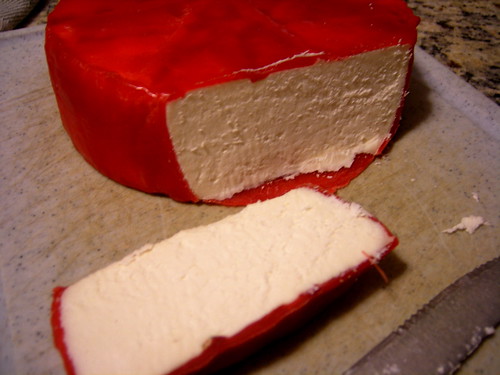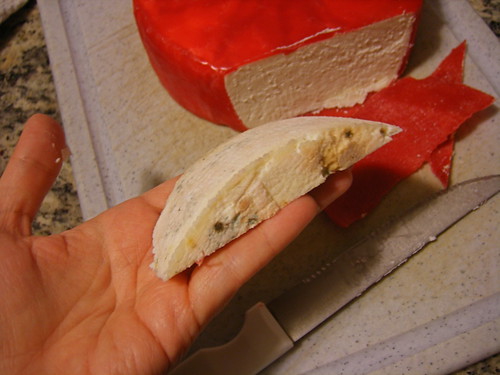Project 5: Farmhouse Cheddar, The Reckoning
So, I was going to come here and post “Cheese Fail” but I don’t think I necessarily need to do that. It’s not so much a FAIL as a sort of unexpected, somewhat of a downer outcome.
What happened is this: we have waited about thirty days for the cheese to age. Our plan was to cut into it this week. I noticed earlier this week that I could see mold under the wax. Oh noes!!! Investigation commenced this evening.
It doesn’t look too bad though not quite the texture I was expecting. It’s very light colored and has not much of a scent. Luckily there does not appear any mold running through the cheese. It’s firm but not hard. However, when you peel back the wax….
Bleh. Not good. Along the sides there is light veins of mold and on the top and bottom in all the little hollows there is some serious moldage. I cut off the moldy bits and my husband and I both tasted it. It’s slightly tangy and a little crumbly. I can’t say that it is anything like cheddar. It’s not bad, necessarily, but I wouldn’t call it exceptionally good. I think this weekend I’ll carve away some more mold and let some unmoldy bits come up to room temp and taste it that way.
I really don’t know what went wrong. Obviously, it was too damp when I waxed it. Before waxing, I had needed to wipe off a touch of mold and perhaps I didn’t get all the spores. I’m going to do some reading up on this but may attempt the farmhouse cheddar again as soon as this weekend. We’ll see. This is certainly a learning process and I’ve gained so much appreciation for cheesemakers.




Sarah said,
November 9, 2008 @ 8:53 pm
I just tasted the cheese and agree with Amanda that it’s not like any cheddar I’ve had before. I’d say it’s probably closest in taste and texture to some goat cheddars I’ve had, but without the goat milk flavor. It is indeed quite tangy. I actually tasted several farmhouse cheddars recently (which were aged much longer), and some of them were surprisingly tangy — but I preferred the ones that were less so.
I think the other missing element in this cheese is salt, and wonder if more salt could have helped to balance out the tang. Maybe I just like salty food, but I think all of the recipes we’ve tried so far have called for too little salt.
I’d be up for trying this recipe again, or jumping to a more traditional cheddar aged several months to see how it compares.
Amanda said,
November 9, 2008 @ 9:41 pm
Sarah, do you recall how much salt was used?
Nicole said,
November 10, 2008 @ 9:12 am
I don’t recall how much salt was added, but I agree that there should have been a lot more. The cheese was fairly bland and while there was a certain amount of tang I wouldn’t say that it was a cohesive flavor. The tang kind of came after the blandness, and then the whole thing rounded out in my mouth with an over-powering sour flavor. (But that just might be because I didn’t cut away all of the mold or something – opps.)
It was nice to see that the cheese had a firm texture and that the general process seeemed to result in the desired effects. I’d like to try this again with a little more preparation on my part to figure out possible ways to get a richer flavor.
I suppose all our cheesemaking attempts can’t be rip roaring successes, but I wouldn’t say this was a complete bust. Echoing Amanda’s statement, I have even more appreciation for cheesemakers everywhere making delicious tasting cheeses. It’s also nice to have completed a hard cheese project so that we have an experience on which to base our questions and research for the next time.
FUCheese » Hard Cheese Class at Kookoolan Farms said,
March 26, 2009 @ 10:03 pm
[…] has been making her own cheeses for over 30 years. The focus was on cheddar! You may recall in the Cheddar Incident of Aught Eight that our first go at a hard cheese didn’t turn out so well. We’ve all been talking […]
sue said,
October 27, 2009 @ 1:37 pm
The problem is undersalting…which allowed your cheddar to become too acidic.
Sue in Vt